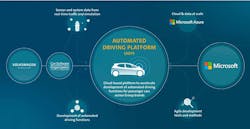Cloud-Based Platform Speeds Development of Automated Driving Functions
The primary challenge of connected driving is using technology to create automated driving functions that can be tested, deployed, and operated. To that end, Volkswagen Group’s Car.Software Organisation is collaborating with Microsoft to build a cloud-based Automated Driving Platform (ADP) on Microsoft Azure, leveraging its compute and data capabilities to deliver advanced driver-assistance systems (ADAS) and automated-driving (AD) experiences.
The companies, which plan to start working on an ADP immediately, are looking to expand the functional scope of the development platform. Both companies also intend to enable technology partners to build tools and services that integrate with the platform to enhance the creation of AD and ADAS solutions.
Volkswagen first entered into a strategic partnership with Microsoft to accelerate development of a dedicated automotive industry cloud, known as Volkswagen Automotive Cloud or VW.AC. Designed to provide a smart and scalable foundation for connected vehicles, VW.AC is expected to handle data from millions of vehicles per day, with the goal of delivering connected experiences to customers around the globe starting in 2022.
“Software decides how people will experience and use their cars in the future. We want to take advantage of these opportunities. The Automotive Cloud helps us realize new business functions like remote control services, electric vehicle charging scenarios, and over-the-air updates,” says Dirk Hilgenberg, Chief Executive Officer of Volkswagen’s Car.Software Organisation. “We’re building a cloud that will scale to serve millions of customers around the world and will enable us to deliver ever-increasing customer value much faster.”
Stepping Up Software Presence
Founded last year, the Car.Software Organisation is expected to play a key role in the transformation of the Volkswagen Group toward becoming a software-driven mobility provider. It expands the Group’s software competencies, including the development of high-performance driving functions for passenger cars that will be integrated into future models of Volkswagen Group’s brands. Cloud connectivity, VW adds, also enables the company to deliver vehicle updates and new features independently of the vehicle hardware, to improve the customer experience.
The Volkswagen Group anticipates doubling its spending on digital development to approximately $28 billion over the next five years. Under the Car.Software Organisation, the automotive giant is building its own end-to-end software platform that includes VW.AC, an in-car operating system (VW.OS), and capabilities for the next generation of infotainment and vehicle performance.
Currently, the Volkswagen Group writes less than 10% of the software embedded in its vehicles, the rest of which is tied to third-party-owned proprietary software. With efforts like VW.AC, the Volkswagen Group aims to write 60% of the vehicle software in the next few years, providing a foundation for integrated end-to-end software.
Around 4,000 engineers and developers around the world are building this software platform for all brands of Volkswagen Group. It includes a unified architecture, an operating system, and the automotive cloud. In addition, it will help with such digital automotive features as AD and ADAS solutions; infotainment platforms; software functions for linking powertrains, chassis, and charging technology; as well as new ecosystems and digital business models in and around the vehicle. The new software platform will first come into play at the end of 2024.
ADAS and automated driving vehicles can help improve passenger safety while reducing congestion and making mobility more comfortable. Building these solutions requires large-scale computational capabilities. Petabytes of data ranging from road and weather conditions to obstacle detection and driver behavior must be managed for the training, simulation, and validation of AD functions. Machine-learning algorithms that learn from billions of real and simulated miles driven are key to the connected driving experience.
Automotive Cloud
Cloud computing can help enhance existing services like emergency assistance or remote vehicle access, while building the foundation for new ones such as intelligent navigation, smart parking, and automated driving. For electric vehicles, the automotive cloud could power an in-car navigation system to provide charging-station locations and recommended stops to avoid range anxiety. Beyond that, the cloud could harness driving and battery data generated by EVs, to help optimize and develop batteries with longer range and higher performance.
VW claims the collaboration will simplify the developer experience. Partners will be able to build AD and ADAS solutions faster utilizing “learnings from miles driven” through a single database comprising real traffic data from the Group’s vehicles, as well as simulation data based on Microsoft Azure’s compute, data, and machine-learning services.
According to Volkswagen, the ADP will trim software-development cycles “from months to weeks,” with the prototype and finished products alike able to be downloaded, tested, and updated remotely thanks to its cloud basis.
VW.AC’s engineering team, based in Seattle, has made it possible for data to be exchanged between the vehicles and the cloud through Azure edge services. The first VW.AC connected test fleets are expected to hit the road in 2021. Production rollout is planned for 2022. VW’s Car.Software Organisation will integrate ADP and VW.AC as the company moves toward further integrating its software solutions, tools, and methods to empower its engineering teams, customers, and partners globally.

